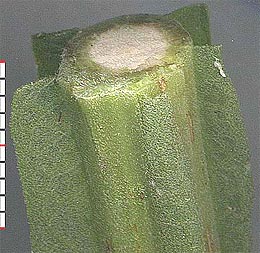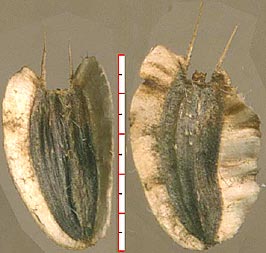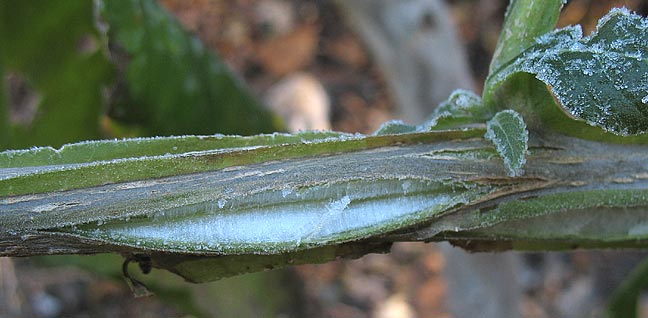A failed hunch
My familiarity with
V. virginica, with its winged stems, initially led me to suspect a direct connection between its winged stems and crystallofolia. Moreover, its achenes (seeds) also have wings. Two considerations led me to reject this hunch: (1) most species that exhibit crystallofolia lack winged stems; and (2) crystallofolia doesn't occur at the same place on the stem as the wings.
wing: a flattened expansion of a fruit, seed or pollen grain; a thin flange of tissue extended beyond the normal outline of a stem or petiole; ...
[Glossary of the Missouri Botanical Garden]

Wings of V. Virginica stem |

Wings of V. Virginica achenes
|

Epidermis rupture not aligned with wings
|
Yet additional evidence was provided by another local Texas
V. virginica population, with winged stems, that has not seemed to exhibit crystallofolia. I first assumed that this was because it was on a dry, west-facing hillside – thus not enough moisture. This has proved wrong: during the rainy fall of 2009 those plants had plenty of moisture, and grew large. And during the record drought of winter 2008 through September 2009, the hill country population (including
Pluchea odorata) continued to
exhibit icing through the drought. I also assumed that the location was too warm – with no hard frosts in that area in 2007 and 2008. Although a December 2009 25° F frost failed to produce ice, finally, with a record low temperatur of 19° F crystallofolia did occur (for the first time). An additional interesting difference in the two populations is that the achenes of those with limited frost lack wings, atypical for
V. virginica. The difference in the two populations might seem to be genetic rather than environmental.
A significant indirect relationship between wings and crystallofolia
Although winged stems proved to be neither necessary nor sufficient, they do reflect the presence of well developed xylem (parenchyma) rays for carrying water and nutrients to the stem periphery, where the wings develop. This is perhaps the most important anatomic requirement for crystallofolia to occur during plant dormancy regardless of the presence or absence of stem wings.
We might also speculate that many species possess appropriately developed xylem rays when fresh and green (cf. Caspary), thus accounting for observed frost formations with annuals and exotic garden plants. But this capacity is lost with age and when the stems dry in the fall.


